
 |
|
#1
|
|||
|
|||
|
Captain knew The Admiralty meant these orders as a coup de grace, a public defeat to put Captain in his place. Before his talk with Crew (aka darn cat), Captain might have read his orders as the crushing defeat they were meant to be. But, not now. The smug young staff ensign who had delivered The Admiralty’s orders was clearly waiting for Captain to signal defeat by affirming he would comply. Captain hid a smile when, instead of offering the expected “roger, wilco,” Captain silently handed the headquarter’s toadie a couple of pages titled “Delta Fishing Instructions.” “You mean you already finished?” stammered the youngster. Captain knew the smarmy staff puke would be grilled by The Admiralty, who would be anxious to hear every sign of Captain’s discomfort as he faced what was meant to be days of work, each minute a humiliating defeat in payment for his earlier defiance of The Admiralty. Captain offered the smallest of smiles to answer the ensign, “That is all, ensign, RTB.” It would not go well for the ensign back at headquarters. “Delta Bass Fishing Instructions.” Reread “Delta Bass Fishing” Delta bass fishing can be easy, a wide-open 40-fish-plus-day funfest, where anything and everything works everywhere. But that is not likely. Even the best-prepared angler will experience days where there is plenty of fishing but little or no catching. Consider approaching each fishing day as part of a lifetime of learning. These instructions are specific to small boat angling, but express principles applicable to any form of Delta bass fishing. These instructions are geared primarily to largemouth bass fishing but are applicable to the smallmouth fishing found in the clearer, swifter water areas of some of the rivers entering the Delta. When things are not working according to plan, consider reversing everything in the rulebook. Do the opposite of the guidelines suggested here. Gear: Any form of rod, reel, line, and bait, fly, or lure can be used for Delta bass fishing, including the simplest hand lines. Experienced anglers will often carry multiple rods and reels of various types, much like the clubs in a golf bag, optimized for various weights of line, lure, bait, or fly. The most efficient outfit to start with is the one you already have. Conventional bait casting equipment and artificial lures are probably the best for this type of fishing day in and day out. While there are many variations, a bait casting reel that holds at least 100 yards of 12 pound test line, attached to a 6 to 7 foot fast action rod, can be used for most Delta bass fishing. Similarly equipped spinning outfits will work. Lighter spinning gear is sometimes used, especially in tough winter conditions. A 6-plus weight flyrod with a 4-foot-plus level leader of 10-pound-plus test fluorocarbon can be used for most Delta bass fishing. Bigger outfits are often used when fishing areas frequented by striped bass or for fishing floating critters in weedbeds, tules, or other heavy cover. Smaller outfits can be fun but you may find yourself overpowered. Variations and specialty rods, like flipping and pitching sticks, are readily available to the enthusiast. Location: You can fish for bass anywhere in the Delta. Reread “Delta Bass Fishing” Structure and Cover Experienced anglers look for locations that offer a variety of “cover,” and “structure.” Cover and structure are often used interchangeably in angling literature and discussions. For our purposes we do not care so much for strict definitions. Just learn that bass are ambush predators who prefer not to chase but to dart out to catch, or flare their gills and suck in, prey that has not detected their presence until it is too late. Think housecat not cheetah. Look for weeds, wood, and manmade objects that offer bass places to hide next to, but not in, current and sunlight. (Some also consider deep water to be “cover.”) Better locations typically have a combination of two or more of these elements adjacent to each other, such as weeds and wood, weeds and riprap, wood and pipes, etc. The best locations may have three or more elements adjacent to one another, such as weeds, wood, and riprap, etc. (Some elements, like riprap, offer by nature differences of size, texture, placement, etc., so that by themselves they are complex.) Think complex variation not simple uniformity. Depth Changes Look for dramatic water depth changes that allow bass to move vertically up and down in the water column in a short horizontal distance. Steep banks, deeper cuts next to flat shallows, ditches or channels through levees or islands, and clear passages through weed beds, are all good examples. Some anglers think of this as “deep water access.” Observation of a given location at high and at low tide, and use of fishing sonar, can help detect such depth changes. “Deep” is a relative term and subject of endless debate; let the fish tell you if it is deep enough. Current Changes Look for dramatic changes in current, whether created by tide, wind, or river flow. Narrow flows through small channels, levee breaks, ditches, pipes, etc. that enter larger calm water areas typically have eddies on both sides of the narrow flow. (The Delta often has relatively wide shallow areas that the tides fill and empty through relatively narrow deep areas.) Better locations are back eddies or protected pockets or corners next to the stronger flows. Wind Small boat anglers often find strong wind in the Delta inhibits their ability to fish. A common wind pattern is: relatively calm in morning, getting stronger through the afternoon, and calming again in the evening. Check the weather forecasts before fishing. Given the prevailing west to northwest winds, look for parts of the Delta waterways near your launch area that run at right angles to the wind, are protected by taller trees or brush, or have a combination of such wind protection. Consider fishing areas that will be more exposed to wind early or late in the day, and areas more protected from the wind in the middle of the day. Water Temperature There can be dramatic differences in water temperature in relatively short distances in the Delta. Typically river inflow and ocean-influenced incoming tides on the main boat channels are cooler. Typically water just rising and falling at the back of either dead-end or loop sloughs, or flowing back out of shallow areas (like sunken islands or weedy back bays) as the tide goes out, is warmer due to exposure to sunlight. This is most dramatic in summer but can be significant in winter when there are sunny days. Generally, the warmer the water temperature is the better the fishing in the Delta. Generally, warmer water flowing into cooler water is better than the reverse. Look for water flowing out with the falling tide from the back of either dead-end or loop sloughs, or out of shallow areas. (These guidelines may be reversed in the dead heat of summer when water is too warm.)
__________________
StocktonDon - fishing, diving, sailing - and wondering what's around the next point. (A pen name for quasi-fictional-hopefully-amusing stuff by dwest.) |
|
#2
|
|||
|
|||
|
Tide The effect of the tide on current and water temperature is introduced above under those headings. Strong wind creates water effects similar to currents that can either increase (if in the same direction as tidal flow) or decrease (if in the direction opposite to tidal flow) the apparent tide experienced in a given area. The quantitative difference in height between adjacent high and low tides determines the strength of tidal effects (not much change from one to the other means not much tidal flow). Generally, high tide creates a larger volume of water to search for fish so if you are fishing randomly your chances drop. Generally, low tide creates a smaller volume of water so if you are fishing randomly your chances rise. However, the point of these instructions is that you should not fish randomly, so these general rules of chance should not apply to you. In fact each tide situation creates a different set of conditions, some of which increase your chances of fishing success at each tide. High tide is the great deceiver; every place looks “fishy.” Do your scouting at low tide. High tide generally encourages fish to “move up,” into the shallower parts of a fishing location, and to “move out,” scattering into the larger volume of water now covering a fishing location. Low tide generally encourages fish to “move down,” into deeper parts of a fishing location, and to “move in,” concentrating into the smaller volume of water now covering a fishing location. Look for fish inside (closer to the bank) of cover and structure at higher tides with lures that cover more water per cast and outside (closer to the channel) with lures that probe smaller areas per cast on lower tides. But, of course, not all high or all low tides, or the differences between them, are the same, nor do tides occur at the same time of day, etc. Everything is relative. Get a tide book. Spend time on the water. Pay attention to what is going on around you. Wherever they move with the change of the tide, the fish will prefer the cover, structure, depth, current, temperature, and other factors previously discussed. Your job is to learn the better locations in a given fishing area that have the better combination of factors that become available to the fish due to the changes created by each stage of the tide. You need to fish a given area through as many tide stages and as many times of the year as you can to work this out. Best Locations Look for complex variations of structure and cover, next to or in, dramatic depth changes, next to dramatic changes in current, where warmer water is flowing into cooler water. Look for such places in wind-exposed areas for early and late fishing, and in wind-protected areas for mid-day fishing. Use maps before you go to find all of this. From Bethel Island, consider Little Frank’s Tract aka Frank’s Tract State Park, or Fisherman’s Cut. Beware strong winds and tidal currents. From Big Break in Oakley, consider Big Break. Beware strong winds. From Buckley Cove aka Ladd’s in Stockton, consider Buckley Cove, the Calaveras River, and Burns Cut.. Beware strong winds, boat traffic, and large boat wakes on the main channel. From Walnut Grove, consider The Meadows. Post questions on internet fishing forums, study guide websites, etc. to locate potential fishing locations of interest. Consider rough launching from public parks adjacent to waterways even if they do not have formal launches, but scout them ahead of time. Small boat anglers are well-advised to study maps to find areas where as many of the best location factors occur in the smallest area. Consider looking first for wind-protected areas, then to adjacent prospects. (Often, experienced anglers with fast boats will put together a number of such locations and move, or “run,” from one such spot to the next, trying to maximize time fishing better “spots” or “honeyholes” instead of spending time fishing areas in between spots that have less promise.) Plan to return to your launch site with the wind and tide, not against it. Technique: Delta anglers can use any technique suited to the location and conditions. Once anglers have figured out the “pattern” for a given spot at a given time, focus on one technique may be mot productive. Typically, Delta anglers will have “search baits” that are used to quickly fish large stretches of surface water quickly. Some topwater search baits are: buzzbaits, poppers, and frog lures or flies. These baits are often most effective in dim light conditions but can be effective anytime. Typically, Delta anglers will have search baits used to quickly cover larger volumes of water at different depths in the water column. Some such baits include: crankbaits, ripbaits, streamers, and spinnerbaits. These baits are often effective when topwater baits are not, but can be effective any time. Typically, Delta anglers will have search baits used to quickly cover large distances on or near the bottom. Some such baits include: deep diving crankbaits, jigs, worms, and various critter baits like crawdads and lizards. When used as search baits these are cast relatively long distances and moved along relatively quickly, “swimming,” “bumping”, or “hopping” in frequent or continuous contact with the bottom. Typically, Delta anglers will have “probing baits” used to slowly investigate the inner reaches of dense cover or structure. Some such baits include: jigs, worms, and critter baits, like crawdads and lizards. When used as probing baits, these are cast, flipped, or pitched relatively short distances, allowed to fall, and moved slowly or not at all, in contact with cover, structure, or the bottom. Some types of baits lend themselves to considerable variation in even a single retrieve. Plastic worms, jigs, etc. can be fished by doing everything from letting them lie still (aka “dead sticking’) to rapidly and erratically swimming or ripping them. Spinner baits can be “waked” just under the surface, let fall on slack line, “burned” through any part of the water column, “slow rolled” ticking just off the bottom, and many other variations. Crankbaits can be flipped into heavy cover, ripped, etc. Feel free to be creative in your fishing. Silvery shad-type and red-dark crawdad-type baits are most common. Every color, shape, and weight variation finds some success in the Delta. Live bait can be used, either suspended under a float or bobber, or cast or allowed to sink. Live shad, minnows, crawdads, worms, and crickets are common live baits used in the Delta. Check current Department of fish & Game regulations. Because fish tend to ingest these baits deeply, it is often impossible to practice successful catch-and-release with live bait. This is not an issue when survival fishing but, especially given minimum size regulations, live bait fishing is not normally a favored idea when fishing for bass in the Delta. Every variation of rigging and of cast and retrieve imaginable can be used on the Delta. Please consult commercial literature for these variations, which change, and come in and out of favor, over time. Experimentation is often a key to success.” Captain was not happy to have authored these instructions. Anglers should experience the skill-building pleasure of piecing things together for themselves. But orders are orders. In any event, Captain felt the instructions struck the right balance between too much detail and too much theory, while satisfying The Admiralty. Most importantly, Captain had worked to present enough of. Crew (aka darn cat) returned from night maneuvers and found Captain at his desk. “Well. Crew, it’s done. The Admiralty has what was demanded. Hopefully it gives The Admiralty enough to chew over that I will go back to being ignored.” [Did you ‘tell all’?] “No, and I am not sure I could do that without writing a book. There are so many subtleties that a given fishing day presents that I am not sure I could do them justice. It often seems trained reactions have sunk below consciousness and now seem to be instincts; I don’t know how you could dig all of those out. How do you know a bass just turned on your spinnerbait or crankbait but didn’t try to eat it? Why do you set the hook on a plastic worm? There is so much more. I am sure every experienced fisherman knows most of that anyway.” [So how are you feeling? Do you think you sold out the Delta? Crew asked.] “No, I am all right. As I got into it I realized the complexity of Delta fishing would protect its best secrets from all but the dedicated and thoughtful angler, and they fully deserve to know them.“ [What are you going to do if The Admiralty doesn’t think you have done enough?] “Offer on-the-water guide service, I guess!”
__________________
StocktonDon - fishing, diving, sailing - and wondering what's around the next point. (A pen name for quasi-fictional-hopefully-amusing stuff by dwest.) |
|
#3
|
||||
|
||||
|
Bravo, Bravo
Very, very nice report on The Delta, Thank You  Scott, Rickey and myself were up there a few years back at the Sugar Barge at Frank's Tract doing some bass on the fly. We launched our kayaks and putzed around close by playing in the weeds and grass then went out through an opening in the sea wall to Franks Tract. Scott, Rickey and myself were up there a few years back at the Sugar Barge at Frank's Tract doing some bass on the fly. We launched our kayaks and putzed around close by playing in the weeds and grass then went out through an opening in the sea wall to Franks Tract. I was again humbled by the expanse of the delta, and the fact that Frank's Tract is referred to as a small section, but one I could not see across it was so huge. I still have fond memories of the delta, sometimes getting into the bass, and sometimes not. If I could fish for two weeks every year, one would be at The Delta, the other in The Sierras. As of late, The Sierras has been calling stronger though...so I must go. TC&TL, Perry
__________________
Work...The curse of the fishing class  ====================== Cobra Mariner-XF kayak Outcast Super FatCat float tube Creek Company ODC 420 float tube |
|
#4
|
|||
|
|||
|
Scouted out the 8 Mile Road launches into California’s Sacramento-San Joaquin Delta. (Take Interstate 5, go west on 8 Mile Road).
http://maps.google.com/?ie=UTF8&z=12&ll=38.048361,-121.419868&spn=0.192499,0.186768&om=1 Just before the first bridge, take a left to go to Paradise Point. This is a full service marina with boat rentals, a general store, and The Breadfruit Restaurant (Caribbean food, mon!). It also has an observation tower and a picnic area designed to be out of the hot summer sun. 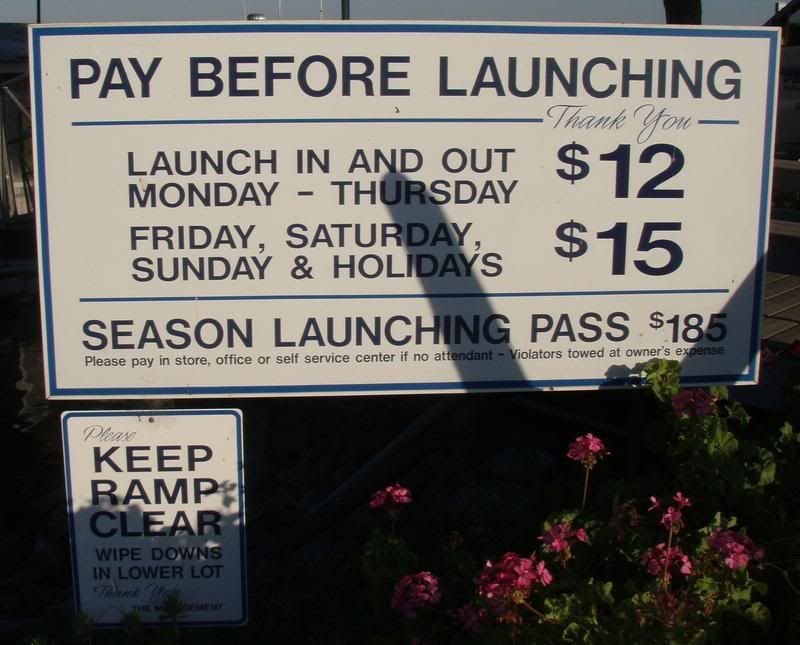 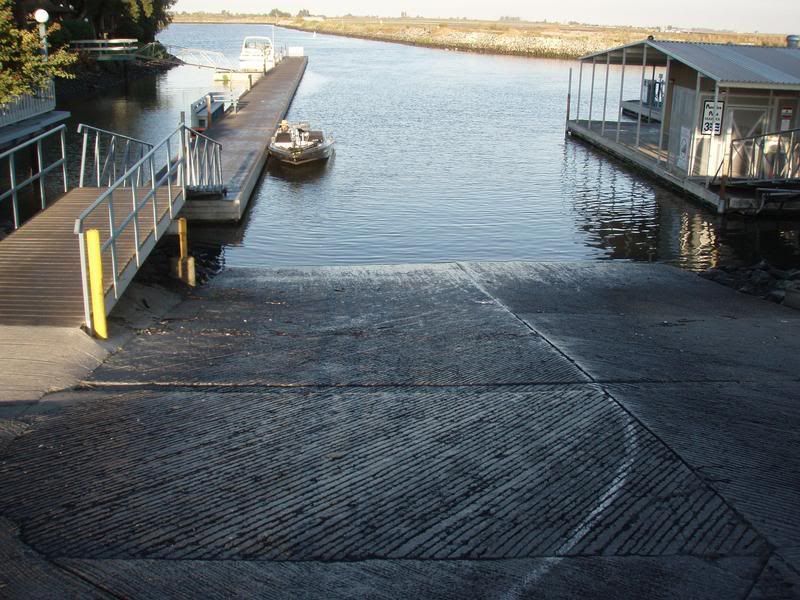 Back on 8 mile Road heading west you come to the second, green, bridge. Turn left to go to King Island resort. A somewhat smaller, rougher launch. General store.  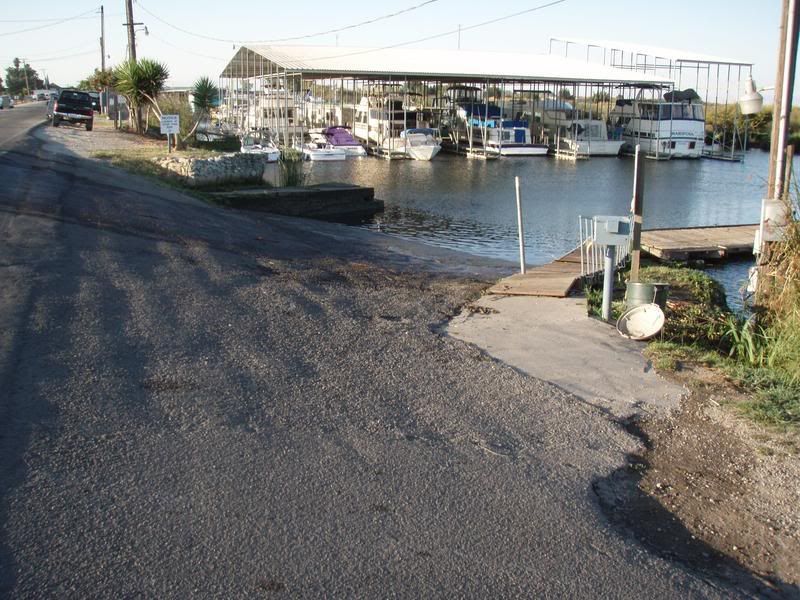 Back on 8 Mile Road going west, just across the green bridge turn right onto Correia Road. Keep going as the road turns from rough paved to well graded gravel and back again a couple times. You will notice a cement ferry ramp with its mate across the slough. . 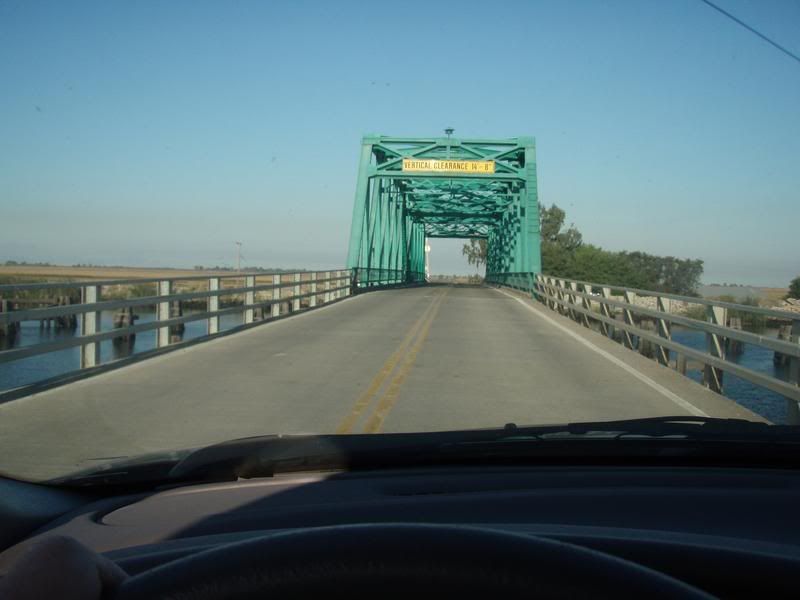  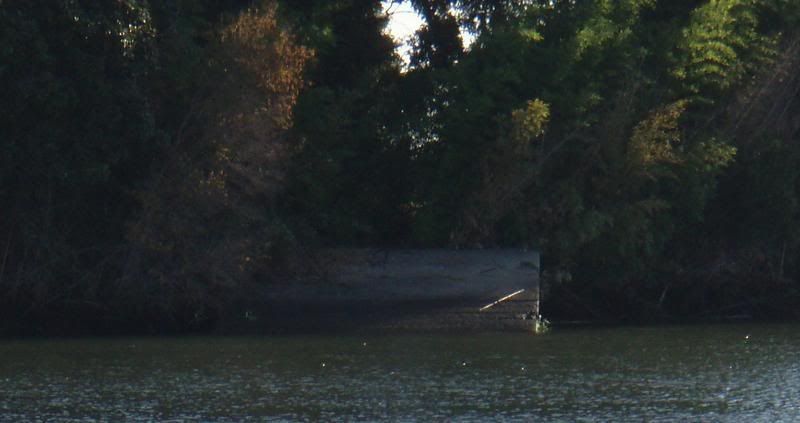 Go back to 8 Mile Road, turn right and go to the end of the road. Turn left and go to the end of the paved levee road. You will see a wooden ferry ramp to your right. There is a “no everything sign,” so it is your decision whether or not to use it. I’d tell you about my decades of experience there, but I better take the 5th. 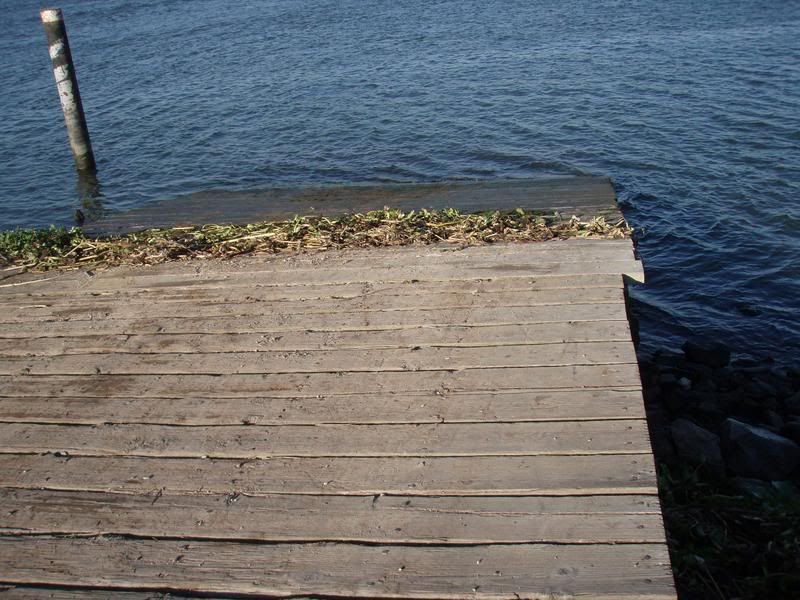 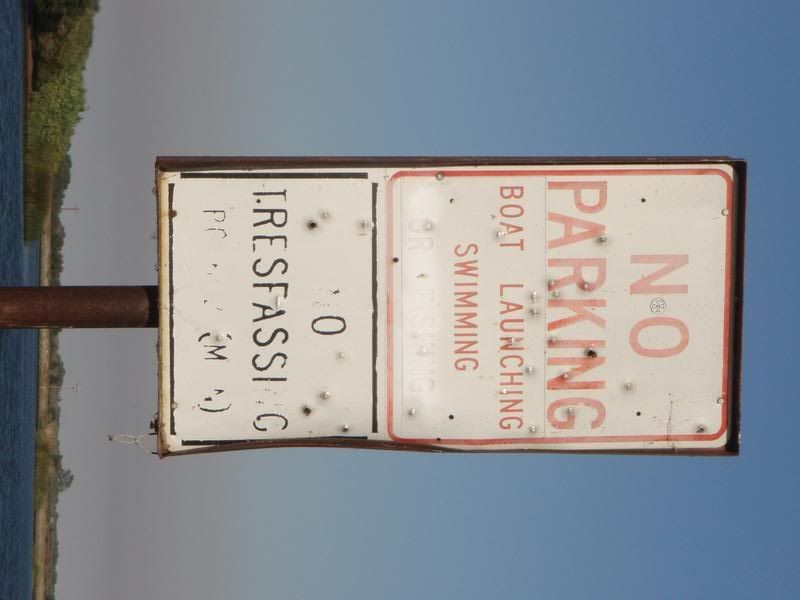 Turn around and go back on the levee road , cross 8 Mile Road and you are at Herman & Helen’s resort. A floating restaurant, store, and a small launch ramp squeezed in.   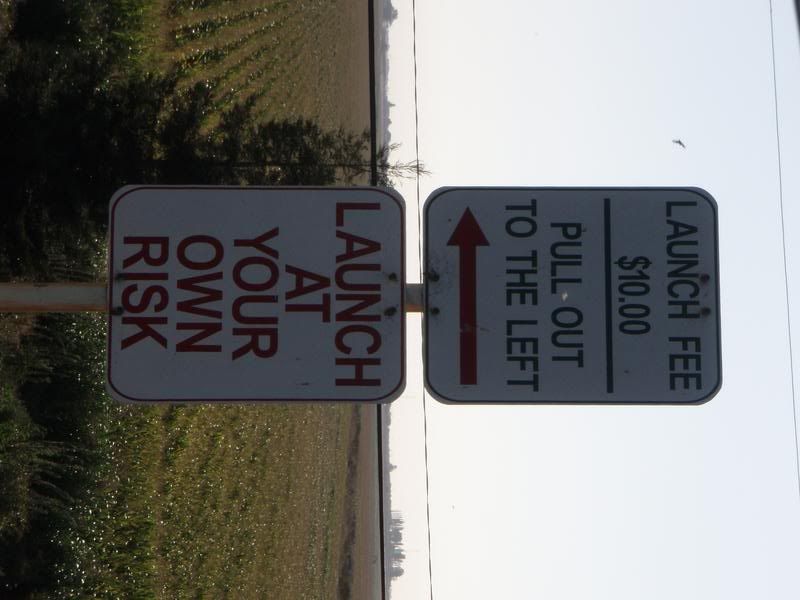 There is bank fishing here and there off most of the roadways, and if you had an adventurous frame of mind you might be able to rough launch also.
__________________
dwest - just a guy. (Occasionally posting quasi-fictional-hopefully-amusing stuff under the pen name StocktonDon.) Last edited by dwest; 09-16-2006 at 10:58 PM. Reason: second thoughts |
|
#5
|
||||
|
||||
|
Thanks for the launch spots
 One looked like the one at The Sugar Barge, but they all have a similiar look to them. Do you have to pay the launch fee to launch your kayak? I believe we payed it, but what the hey it was still a blast. One looked like the one at The Sugar Barge, but they all have a similiar look to them. Do you have to pay the launch fee to launch your kayak? I believe we payed it, but what the hey it was still a blast. Perry 
__________________
Work...The curse of the fishing class  ====================== Cobra Mariner-XF kayak Outcast Super FatCat float tube Creek Company ODC 420 float tube |
 |
|
|